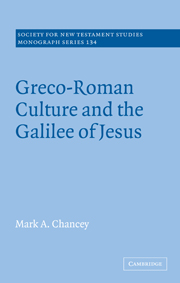Mark Chancey’s Greco-Roman Culture and the Galilee of Jesus, reviewed by Thang San Mung
 Mark A. Chancey, Greco-Roman Culture and the Galilee of Jesus, Society for New Testament Studies Monograph Series 134 (Cambridge: Cambridge University Press, 2005), 304 pages, ISBN 9780521091442.
Mark A. Chancey, Greco-Roman Culture and the Galilee of Jesus, Society for New Testament Studies Monograph Series 134 (Cambridge: Cambridge University Press, 2005), 304 pages, ISBN 9780521091442.
Mark Chancey, Assistant Professor in the Department of Religious Studies at Southern Methodist University, challenges the consensus of the cultural influence of the Hellenistic Romans on the Galilee during the lifetime of Jesus. This monograph is a composition of seven major chapters with an introduction and conclusion. To support the discussion, the author provides several study-helps such as a map in the prescript, an appendix listing Galilean names of the first century CE, as well as several indices.
With a strong criticism of Martin Hengel’s claim regarding Hellenistic influence on first century Palestine, Chancey opens his pages with the call to rethink the impact of Greco-Roman culture of the Galilee of Jesus’ time. Depending heavily on recent archeological findings and others’ published works, Chancey challenges the traditional understanding of Palestine and Galilee as being completely Hellenized.
Chancey, in chapter one, argues that “the absence of evidence is probably not solely due to accidents of survival and discovery, but rather to the slow pace of Hellenization” in the area (p. 42). Moreover, in chapter two, he is confident that even the arrival of Roman general Pompey in Palestine in 63 BC did not affect the Galilean region significantly. Therefore, according to his observation, the centurion in the story of Jesus is not necessarily a Roman officer but probably a Herodian guard.
However, Chancey acknowledges the gradual introduction of Greco-Roman culture since from the time of Herod the great as certain Hellenistic styled constructions were carried out during his period. In fact, in chapter three, he points to Herodian client kings along with Pompey as those who brought Hellenism into Palestine that slowly spread into upper Galilee in later decades. According to chapter four, the remarkable growth of Hellenization in the area should be dated as late as the second and third centuries CE.
Further, with the support of very less Hellenized literary production dated from first century CE (e.g., Mark, Hebraic Mishnah) and lack of a standard compendium of Galilee’s inscriptions to support Hengel, Chancey in chapter five boldly asserts no common use of Greek in Galilee during the lifetime of Jesus. Tracing the story of minted coins in Palestine in chapter six, Chancey again argues the full bloom of Hellenization in the region only after second or third centuries CE since pure Roman coinage were first available only by the mid third century.
Chancey draws his primary argument from the use of arts in the Galilee of the time, which he covers in chapter seven. He reads the relatively limited adoption of Greco-Roman arts during the first century as a culture “that reflected the traditional Jewish abhorrence of ‘graven images’.” With the support of all these evidences, Chancey, in his concluding remark, criticizes current scholarship, saying “the extent of that Greco-Roman culture in Galilee during the lifetime of Jesus has often been greatly exaggerated.”
Indeed, this scholarly research is a reflection of current debates between the “purists” and the “Hebraists”. With his probable preference of the “Hebraist” camp, Chancey offers convincing evidence against the traditional overstatement of Hellenistic influence on the Galilee of Jesus’ time. Especially, his references taken from numismatic, epigraphic, and architectural evidences are compelling. All these references may become valuable sources for further study on this subject.
Category: In Depth


